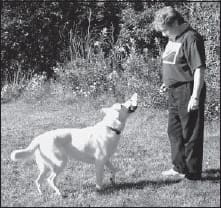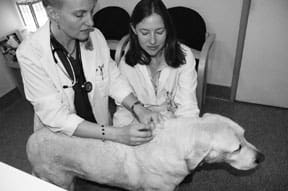Antioxidants are all the rage nowadays, seemingly good for anything that ails you or your dog. Antioxidants, natural and otherwise, are also widely used as preservatives in processed foods for pets and their people. With dog antioxidants having benefits that your canine friends can enjoy as well.
Antioxidants are, however, another of those things that the more the scientists learn about them, the more they learn they don’t know. This paradigm seems to repeat itself in the realm of holistic health!
Dog antioxidants offer a host of mechanisms that protect the body from a variety of diseases, and these benefits have been supported by thousands of scientific articles. On the other hand, the mechanisms of action of the antioxidants vary somewhat among species, and not all diseases respond favorably to antioxidant administration all the time; some dosage levels of antioxidants may actually increase the incidence and severity of certain diseases. Also, individual dogs may have different needs for antioxidants (both due to a differing ability to absorb antioxidants from the gastrointestinal tract and from individual metabolic needs. And the methods used to grow and/or produce the substance that contains the antioxidant has a direct bearing on how much of the antioxidant’s bioactivity is available to the animal.

288
Furthermore, the way antioxidants are supplied to the body greatly affects the amount of good they can do. For example, commercially prepared supplements are much less effective than whole foods that contain the antioxidants.
And finally, there is considerable evidence to support the concept that mixing antioxidants often creates a synergistic effect that is much greater than would be the combined effects of the individual antioxidants. Determining the best way to deliver the benefits of these marvelous substances to your dog, then, may require some study.
Dog Antioxidant Activity
The term “antioxidant” refers to the activity demonstrated by numerous vitamins, minerals, and other phytochemicals (bioactive chemicals found in plants) to serve as protection against the damaging effects of highly reactive molecules known as free radicals.
During healthy metabolism, carbohydrates and sugars are “burned” in the presence of oxygen to provide the animal with energy. Most of the raw materials involved in metabolism are converted to energy. In all energy reactions in the body, however, there are some molecular fragments that aren’t totally used up. Some of these chemically active fragments have an electrical charge due to an excess or deficient number of electrons. These charged molecules are called free radicals.
Because they have one or more unpaired electrons, free radicals are highly unstable. They scavenge the animal’s body to grab or donate electrons, thereby damaging cells, proteins, and DNA itself. Cell membranes of virtually all cells and cellular DNA are particularly susceptible to oxidative damage. Free radical reactions and oxidative damage have been linked to many of the diseases of aging such as arthritis and cancer.
Animal bodies aren’t the only victim of oxidation; this same oxidative process causes oils to become rancid, peeled fruits to brown, and iron to rust.
Normal aerobic respiration and food metabolism creates a constant source of free radicals–which the body can normally deal with–but excessive free radicals can be produced from a whole host of sources, including extreme exercise, inflammatory diseases such as arthritis, and abnormal cell growth associated with most types of cancer. In addition, free radicals come from many outside factors including pollution, sunlight, tobacco smoke, and X-rays.
The free radical theory of aging and disease promotion holds that through a gradual accumulation of microscopic damage to an animal’s cell membranes, DNA, tissue structures, and enzymatic systems, the animal begins to lose organ-system function, and then becomes predisposed to disease.
The healthy dog can process and eliminate free radicals with his body’s own antioxidant enzymes (including glutathione peroxidase, catalase, and superoxide dismutase), but excessive free radicals can produce disease. In the case of the athletic or working dog, oxidative damage may be elevated due to increased production of free radicals. In addition, animals who are already stressed, or aging animals with weak organ systems and waning immune functions may need some help to eliminate free radicals.
External sources of antioxidants are thought to be a useful antidote for an excess of free radicals. Many holistic vets feel that even the healthy animal can benefit from a balanced, daily dose of antioxidants. The majority of popular antioxidants appear to be extremely safe, at least in humans, where most of the safety studies have been conducted. Holistic vets have been using antioxidants for several decades now, with few or no apparent adverse side effects.
Claims for Health and Healing
Following are just some of the claims for the benefits of antioxidants:
Arthritis. Antioxidants, but particularly vitamin C, are vital to any arthritic therapeutic program. Vitamin C is involved in the building and healing of joint and bone structures and it plays an active role in the immune response.
Anti-aging. As an animal’s body ages, it undergoes a gradual accumulation of tiny bits of damage to cell and tissue structures and also to enzymatic systems important in the production of antioxidants. With age, then, the animal’s cells and organ systems no longer have the vital capabilities they once did. The result is an inability to deal with free radicals efficiently; antioxidants improve the efficiency of all the animal’s aging systems, resulting in a healthier old animal.

288
Cancer prevention.
Antioxidants protect the body from the damaging effects of free radicals, slow tumor growth, and/or help cellular DNA retain its normal configuration.
Heart disease. Antioxidants protect the heart and circulatory system from oxidative stress from free radicals.
Vision and eyesight. The antioxidants leutine and zeanxanthin are particularly helpful for supporting good eye health.
Immune function Antioxidants are known to enhance healthy lymphocyte production as well as offering protective factors for other components of the immune system.
Exercise tolerance. Studies indicate that there may be a protective effect from long-term exercise. When exercising produces an excess of free radicals over time, the body learns how to produce an excess of antioxidants, thus developing the ability to respond better to free radical excess in the future.
How to Dose With Dog Antioxidants
There is considerable evidence to indicate that antioxidants from a natural, dietary food source are much more effective than those taken in a supplement or pill/capsule format.
It’s a bit more complicated to try to sort out the controversy involving natural vs. synthetic forms of the vitamins. Often the synthetic form of a vitamin is an isomeric chemical–structured in a mirror image of the natural form of the chemical, but the same in every other way. Thus the natural form of vitamin E is labeled “D” and the synthetic form is labeled “D,L.” It is said that the synthetic form is only half as active as the natural form. Some nutrition experts think this isomerism is significant, and that synthetic forms should be avoided; others think it is meaningless and the nutrients are equivalent.
Most antioxidants found in foods are made more readily available after the foods have been pureed and/or naturally heated–the antioxidant lycopene, found in tomatoes and other food sources, is an example here.
The exception to this rule is vitamin C which is destroyed by heating. Drying foods usually diminishes the amount of vitamins and antioxidants available to the animal–the amount of decrease in activity depends on the food source and the method of drying. It is also thought that microwaving destroys many nutrients, including most, if not all, the antioxidants.
Many of the antioxidants work synergistically; the sum of the activities of several different antioxidants is often many times higher than would be obtained by adding the sum of their accumulated effects together.
Perhaps the most important thing to appreciate about antioxidants (and actually any other nutrient) is that they often work in a balanced fashion.
Some antioxidants, if given in excess, may disrupt the balancing act of other antioxidants, or one antioxidant may actually interfere with a vital function of another antioxidant. Or, one antioxidant (or other cofactors) may be necessary for the proper functioning of an unrelated antioxidant.
For example, an excess of vitamin C may cause a general “unbalancing” of the oxidative system resulting in oxidative damage. It is well-known that vitamin E and selenium are virtual “cofactors” and their dosage needs to be balanced to make either one effective. And zinc, considered an antioxidant by itself, is a vital component of several other antioxidants and enzymatic systems.
This all boils down to a few general rules: ¡ Whenever possible, use natural food sources known to be high in antioxidants. ¡ If it helps make the food more palatable for your dog’s taste buds, go ahead and chop up vegetables, fruits, and herbs, heat them naturally, and hide them in some of your dog’s favorite foods. ¡ Use several sources to provide a mix of antioxidants; herbs, vegetables, fruits, and berries are all excellent sources, and many of these will provide a healthy stew of a variety of antioxidants. ¡ Do not overdo any one antioxidant. A healthy balance is the key, again best provided by giving a mixture of many antioxidant sources in the diet.
Popular Dog Antioxidants
There are four key antioxidants–vitamins A, C, and E, and selenium–and many others have been recently popularized.
Vitamin A is a group of compounds that play an important role in vision, bone growth, reproduction, cell division, and cell differentiation. Vitamin A helps regulate the immune system, and it promotes healthy mucosal surface linings of the eyes, and the respiratory, urinary, and intestinal tracts.
Vitamin A found in foods that come from animals, known as preformed vitamin A, is absorbed in the form of retinol which is one of the most usable and active forms of vitamin A. Rich sources of this type of vitamin A include liver and whole milk.
The vitamin A found in colorful fruits, vegetables, and herbs is called provitamin A carotenoid. Common provitamin A carotenoids found in plant-based foods include beta-carotene, alpha-carotene, and beta-cryptoxanthin. Among these, beta-carotene is the one most efficiently converted into retinol, the most active form of vitamin A.
Of the over 600 carotenoids found in nature, about 40 are present in a typical (human) diet; most of these have antioxidant activity, but only 14 of them (or their metabolites) have been identified in human blood and tissues. Of all these, B-carotene is the most studied, since it is the most common carotenoid found in fruits and vegetables.

Lycopene and lutein are two carotenoids that do not have vitamin A activity, but have other health-promoting properties. More information on lycopene and lutein can be found below.
Carotenoids can promote health when taken at dietary levels, but they may actually have an adverse effect when taken in high doses by certain individuals. (Human subjects who smoke or who have been exposed to asbestos may have negative results from high levels of antioxidants).
The exact mechanism that explains all the activities of the carotenoids is not known, but we do know that most have a potent antioxidant activity. Other mechanisms may include: a provitamin A activity (promoting the production and/or activity of vitamin A); activation of the gene responsible for cell-to-cell communication; and modulation of certain enzymes (especially lipoxygenase) that help remove free oxygen radicals.
How much carotenoid is available to the animal depends on: the source of the food and other dietary factors, food particle size, and location of carotenoid within the plant¡¯s cells. Mixing carotenoids with other antioxidants in the food (e.g., vitamin E) can increase their activity.
There is a large body of scientific evidence that consistently reveals beneficial effects of taking carotenoids to help prevent cancers of the upper gastrointestinal tract and respiratory system.
The term vitamin C applies to water-soluble substances that possess activity that protects against scurvy, a disease that results in bleeding gums, poor wound healing, and other symptoms. The terms vitamin C, ascorbic acid, and ascorbate are used interchangeably by most nutritionists. Calcium ascorbate (used in the patented product “Ester-C”) and sodium ascorbate are not acidic (and so do not upset the tummies of sensitive dogs) but, being salts, have a salty flavor. Most animals (but not humans) are able to manufacture their own vitamin C. However, holistic practitioners have long noted that some dogs–especially those undergoing severe or chronic disease states or those exposed to high levels of stress–seem to benefit from supplemental or therapeutic levels of vitamin C. Many of the symptoms of scurvy are due to vitamin C’s role in the formation of healthy collagen, the fibrous substance in skin, tendon, bone, cartilage, and other connective tissues.
Vitamin C is also involved in modulating iron absorption, transport and storage, and it is involved in the biosynthesis of corticosteroids and the conversion of cholesterol to bile acids. Vitamin C is a potent antioxidant that is found naturally in green and red peppers, citrus fruits and juices (and other fruits such as strawberries), and many vegetables and herbs. Vitamin C is a primary factor in the healing of all wounds, helping tissues repair and regenerate, and it is a potent anti-tumor factor, offering both protection and supplemental help for treatment. Vitamin C also has been shown to have antiviral activity as well as acting to help modulate the body’s allergic response and immune system. It apparently has specific protective activity for the respiratory system and the eyes, and it is antihypertensive and protects against atherosclerosis. Vitamin C also helps with the detoxification of heavy metals and other toxins. Vitamin C is absorbed in inverse relation to the amount in the diet. That is (in humans) at a dietary intake of 30 milligrams daily, the vitamin is almost completely absorbed; at 30 to 180 mgs dietary level, about 70-90 percent is absorbed; about 50 percent of a single dose of 1 to 1.5 grams is absorbed; while only 16 percent of a single dose of 12 grams (12,000 mgs) is absorbed. Vitamin C (as D-ascorbic acid) may be added to food as an antioxidant preservative. Cooking destroys vitamin C activity.
I was taught in vet school that dogs do not need supplemental vitamin C because they are able to manufacture it on their own. This may be true, but holistic vets have long recommended that extra vitamin C be given routinely, and most of us feel it is especially beneficial for the animal with a chronic disease or one undergoing stress. Additionally, there is growing evidence that vitamin C may be beneficial for preventing and treating hip dysplasia in dogs. One trial of a small number of dogs gave vitamin C to dysplasia-prone dogs–to the dams throughout pregnancy and until weaning, and to the pups from weaning until they were two years old and none of the dogs developed dysplasia. In addition, several trials have been conducted that show improvement of dysplastic lesions and an apparent lessening of pain when vitamin C is given. In addition many vets–now including conventional and holistic vets–have found that high levels of vitamin C may help an animal recover from acute diseases such as distemper and parvovirus, and chronic diseases such as cancers may also be helped with additional vitamin C. When given orally, calcium ascorbate and sodium ascorbate seem to be the preferred forms of vitamin C for dogs, as it is more quickly absorbed, and it doesn’t cause acidity of the gastrointestinal tract. Suggested doses vary; check with your holistic vet, keeping in mind that many conventional vets still adhere to the ancient concept that vitamins are not necessary since the commercial foods (that they sell) provide all the nutrients that your dog will ever need. Many over-the-counter supplements combine vitamin C with bioflavonoids, or simply flavonoids (sometimes referred to as vitamin P). Bioflavonoids are typically derived from citrus fruits, although many other fruits and herbs are also high in flavonoid content. Studies (in vitro) also show that the flavonoids work synergistically with vitamin C to create an enhanced antioxidant activity. Flavonoids include quercitin, hesperidin, and rutin, along with several others.
Vitamin E is a fat-soluble vitamin that exists in eight different forms; alpha-tocopherol is the name of the most active form of vitamin E in humans and likely in dogs. The natural form is labeled “D”, while the synthetic form is labeled “D,L.” Vitamin E activity and metabolism are directly tied to adequate levels of selenium and zinc, and animals unable to absorb fats (animals with inflammatory bowel disease or persistent diarrhea, for example) may become deficient in vitamin E. Vitamin E is a potent antioxidant and adequate levels of vitamin E are protective against cancer, cataracts, and heart disease. Healthy levels of vitamin E are also required for reproductive health. Food sources rich in vitamin E include wheat germ oil; almonds; sunflower seed kernels; sunflower, safflower, and corn oils; and many vegetables. ¡
Selenium is an essential mineral that is required in trace amounts. Selenium functions as an antioxidant, and it is an important component for helping to create healthy heart muscles. The functions of the thyroid and immune system depend on adequate amounts of selenium, and studies indicate that proper levels of selenium help protect against arthritis and several types of cancer.
Plant-source foods are the major dietary sources of selenium, although the amount of selenium in plants depends on the selenium content of the soil where the plants are grown. Selenium is also found in some meats, seafoods, and nuts.
Excessively high levels of selenium in the body can result in a condition called selenosis, a condition that causes intestinal upset, hair loss, garlic breath, fatigue, irritability, and bone abnormalities. For this reason alone, selenium (and other mineral sources of antioxidants) should not be added to the diet without the guidance of your veterinarian. Also, the activity of selenium is closely coupled with that of iodine, vitamin E, and the amino acid methionine, and it is important to have all these substances balanced for healthy, whole-body functioning.
Zinc is an important mineral found in every cell of the body, and it is a vital constituent of more than two dozen enzymes involved in digestion and metabolism. By itself, zinc is an active antioxidant, and, in addition, it is an essential element in antioxidant enzymes. Zinc also stabilizes cell membranes, provides cofactors for many enzymes involved in visual function, and is necessary for a healthy functioning immune system. ¡ In my opinion, the very best and safest sources of antioxidants (for dogs and people) are culinary herbs, spices, fruits, berries, and veggies.
Almost any of the herbs used in herbal remedies have at least some antioxidant activity, and some herbs come loaded with antioxidant capability. For example, oregano, basil, sage, peppermint, thyme, lemon balm, clove, allspice, and cinnamon all contain very high concentrations of antioxidants; many herbs actually have higher antioxidant activity than equivalent amounts of vitamin C. In addition, herbs are typically high in vitamins C and A, and most have additional antioxidant activity from their selenium content.
Fruits, berries, and veggies are likewise rich in antioxidants, vitamins, and minerals. The key is to find the fruits, berries, veggies, and herbs that your dog likes. Be creative: mix the nutrient-rich goodies with your dog’s favorite foods, cook or warm them for enhanced palatability, and try several different foods until you discover the ones that your dog enjoys most.
Lycopene is a carotenoid that makes tomatoes red, and it is actually the most abundant carotenoid found in the U.S. human diet–most coming from tomato sauce and juice, pizza, and ketchup. Lycopene is also found in red or pink-colored fruits and vegetables such as watermelon and pink grapefruit.
Studies have shown that lycopene is a potent antioxidant, and it has the ability to protect against cardiovascular disease and several types of cancer. Lycopene also helps protect the skin from the damaging effects of the sun’s rays.
My own dog, Pokey, illustrates that there’s more than one way to “skin the dog” and get him to eat his antioxidants. Pokey will devour with gusto almost anything that has been on a human plate . . . anything, that is, except fresh tomatoes. My wife and I have tried to hide a tomato slice under or in his favorite foods, to no avail. The next day we find that the tomato slice has been nudged out of Pokey’s food bowl, and he looks at us with total disdain and disgust for even trying to trick him into eating it.
This is all a bit unusual, because Pokey loves pizza with all its tomato-rich topping, and whenever we bring one home he sits there staring at us in anticipation, with drool running out of his mouth like a faucet. However, I’d rather not feed him too much of the fattening pizza (it’s okay for Sue and me, mind you), so I looked for other ways to entice him to eat his tomatoes.
Turns out it was not so difficult. I simply diced up a piece of tomato, added a pinch of oregano (also rich in antioxidants), heated the concoction a bit, and tried it out in Pokey’s dish. Eureka! Pokey loves my non-fat pizza, antioxidant-rich, tomato gruel.
Leutine and zeaxanthin are yellow-pigmented carotenoids found in high concentrations in egg yolks, yellow fruits, and vegetables as well as in dark green, leafy vegetables and herbs. In particular, spinach, kale, and collard greens contain high levels of these two carotenoids.
In the body leutine and zeanxanthin are found in highest concentration in the macular region of the eyes (the back of the eye were the retina is located) where they are believed to help filter out damaging blue light and prevent free radical damage to the eye.
These two antioxidants are especially good for supporting normal eye health; they may help prevent glaucoma and cataracts.
Other popular antioxidants include superoxide dismutase (SOD), coenzyme Q-10, pycnogenol (pine bark from the tree, Pinus maritime), green tea, mushrooms, raspberries, blueberries, red wine (okay, maybe not for dogs!), and many others.
If you follow the media, you’ll note that the popularity of specific antioxidants comes and goes, seemingly with the tides. Look more closely, though, and what usually happens is that some scientist, closeted in an obscure hidey-hole/laboratory, does a trial on some specific nutrient, and what do you know, s/he “discovers” that that fruit or berry or herb has loads of antioxidant activity. So, following the need to publish or perish, the scientist gets the article published, the media latches onto that particular fruit or berry as the savior of mankind, and commercial production (and a vast advertising campaign) is set into motion.
For those of us who don’t have our heads in the sand, however, this should be much easier. Simply feed your dog a varied diet that includes more fruits, berries, and veggies, and add some spice to his life by adding a pinch of any of a number of culinary herbs every so often.
The KISS (keep it simple, stupid!) way to add antioxidants to your dog’s diet: Start with vitamins A, C, and E, and add small amounts of the most natural form of the vitamin to the diet of all dogs. For a 20 to 40 pound dog, dosages might be in the range of 250 mg daily vitamin C; 100-200 mg vitamin E, and 2,000 I.U. vitamin A a couple times a week.
I still recommend additional vitamins on the theory that all critters in this day and age are exposed to more environmental pollution than our ancestors, and because our dog’s food sources are usually not as natural as they should be.
If the dog is undergoing excess stress or a disease of any kind, I might increase the antioxidant and/or vitamin dosage for a short period. In all cases, I want to try to balance the nutrient input–making sure there’s a balance with selenium and zinc, for example, and this often requires a daily multi-vitamin and mineral product.
And finally, I’ve learned to doublecheck all medications and supplements that the dog is currently being given, to be sure he isn’t receiving a toxic overdose of any one supplement.
So, vitamins may be important, but, to my way of thinking, the real key to providing antioxidants and vitamins is to enhance the dog’s diet with a variety of herbs, fruits, berries, and veggies. Mix them up, vary the diet, add some spice to your dog’s life, a little pinch at a time–and help him stay healthy in the process.




























